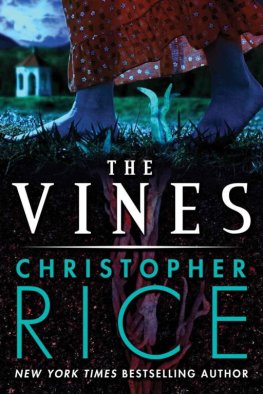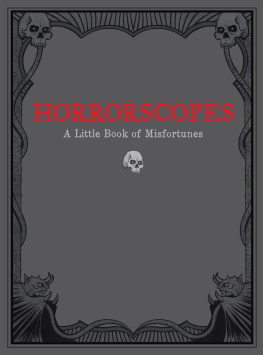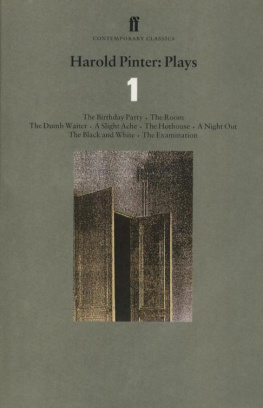Christopher Rice
THE VINES
For David Streets
You have taught me its possible to keep an open heart during the most challenging periods of our lives.

Spring House had its portrait painted many times before it was destroyed by fire. Images of its grand, columned facade are so prevalent throughout gift shops in southern Louisiana most tourists to the region return home with a haunting sense they had visited the place, even if they didnt take a bus tour of the old plantation houses that line the banks of the Mississippi River.
Hundreds of years after the conflagration that reduced the antebellum mansion to timbers and weeds, the house and grounds were restored to a more tourist-friendly version of their original splendor by one of the wealthiest families in New Orleans. Several of the slave quarters were removed to make room for a quaint gazebo, and the cane fields where African slaves labored and died in the punishing heat were replaced by manicured, fountain-studded gardens that have since played host to countless wedding receptions. The affluent families who pay for these events feel no meaningful connection to the places violent, bloody history; otherwise they would have second thoughts about staging such gleeful celebrations atop soil forced to absorb decades of systematic degradation and assault. No doubt, many of the brides in question grew up in homes where an etching or a painting of Spring House hung in the foyer or the upstairs hallway or, at the very least, the guest bathroom, and they too were seduced, sometimes subliminally, by these ever-present reproductions of its pastoral sprawl and muscular profile.
But there is one rendering of Spring House that continues to cause dispute among academics, and it is not found in gift shops. The sketch is primitive, but telltale architectural details of the old house are plainly visible: the widows walk and the keyhole-shaped front door, to name a few. It depicts a gathering of slaves who have been forced to stand and watch while one of their own is whipped by a man who is clearly the overseer. The inexplicable event that seems to have interrupted the overseers work is a matter of great contention among those devoted to the study of plantation history.
Some shape has descended from the branches of a nearby oak tree and twined itself through the overseers airborne whip, capturing it in midair and bringing a sudden halt to the bound slaves violent punishment.
Even though it has no signature or date, the academics and tour guides believe this sketch to be the work of one of the many privileged white historians who took it upon themselves to document the personal narratives of freed slaves after the Civil War ended. Perhaps these accounts of misery moved one of these well-intentioned writers to work beyond the limits of his abilities, resulting in a crude illustration meant to manifest the sublimated rage of his interview subjects.
Or maybe it is the work of a former slave, who summoned all the steadiness of hand she could manage and put her own revenge fantasy to paper. But these scholars are sure the sketch does not depict an actual event. Its a metaphor, they insist, an angry dream spilled in ink. Of this assertion these students, who devote their lifework to studying the bloody and complex history that runs catacomb-like beneath the bus tours and the spinning racks of postcards and the five-figure weddings, are absolutely sure.
And they are wrong.
When she reaches the shadows at the top of the stairs, Caitlin Chaisson is stilled by the sound of a womans drunken laughter. It comes from the guest bathroom a few paces away, where the half-open door reveals two pairs of entwined legs and a womans hands, capped with bloodred nails, tugging a mans trousers down over his ass. She recognizes the mans pants, as well as his slurred, breathy voice, and all at once the banister on which Caitlin is attempting to rest her hand feels as vicious and hungry as a lava flow.
The last of her guests are still draining out of the foyer below, but she feels utterly alone, as if the short distance down the gentle half spiral of the perfectly restored wooden staircase is a dizzying slope, and she is perched precariously at the summit. She wants to shatter this illusion by turning and running down the stairs, by mingling once more among her guests as they retrieve their coats from the indulgent valets. After all, they are her friends, her many cousins, and employees of her late fathers foundation, and they gathered that evening at Spring House to celebrate her birthday. And shes sure if she joins once more in their gin- and vodka-slurred conversations about which member of which couple is sober enough to make the long drive back to New Orleansa serpentine crawl along winding river roads, past shadowed leveesshe will be freed from the terrible implications of what shes just seen. But while the chatter coming up from the foyer below sounds bright and seductive, it is powerless to move her, as cloying and impotent as the condolence cards that poured in after the plane crash that killed her parents. So she remains frozen at the top of the stairs as her final birthday gift unfolds a few paces away.
It is the precision of what she sees next that cuts her most deeply, as if the scene had been staged for her arrival. But she knows this cant be true. The second floor of Spring House is a warren of shadows, and there are still guests sprinkled all over the long front drive, most of them following her gardener and handyman, Willie, as he leads them back to their parked cars with an antique gas lantern raised in one arm. The upstairs bathroom is the quickest escape for two people gripped by drunken lust. Worse, there is nothing calculated about the way her husbands mouth gapes against the young womans exposed neck; rather, a blind passion animates his movements, and despite the deep, agonizing twist in her gut, Caitlin sees it for what it is: adolescent lust. But the childishness of Troys pawinghes almost got the womans right breast free from her cocktail dressdoes nothing to diminish its impact. It is wild and liberated in ways it has never been inside the bedroom theyve shared for five years. It gives the display a terrible, crushing purity.
And the woman. Who is she? Caitlin noticed her earlier, circulating among the other guests, some yat friend of one of her cousins, shed thought. Shed looked wide-eyed and cowed by the masterfully restored plantation house and its sprawling, manicured grounds. And yet, had she been biding her time, waiting to strike? Or worse, had this little betrayal been planned in advance? Is this not the first time her husband has twisted this delicate blondes right nipple in between his thumb and forefinger while gnawing gently on her earlobe?
Caitlin is amazed they cant hear her sharp intakes of breath. She is amazed that the door is open just the right number of inches for her to see the full arc the womans body makes when Troy lifts her up onto the edge of the sink and forces her thighs apart as much as they can go inside the confines of the dress. Caitlin is amazed by the poses, by the props, by the cruel timing of the scene before her. But its content and its meaning both carry the crushing weight of the inevitable. And as five years worth of suspicions are confirmed, Caitlin Chaisson learns that she is not the plucky, courageous woman she has seen in movies. Because though it pains her beyond measure, she cant even bring herself to move, much less throw the bathroom door open and drag her husband out into the hallway by his hair. Indeed, her right foot is still hovering in the air just behind her; shes yet to complete the final step that brought her here.












